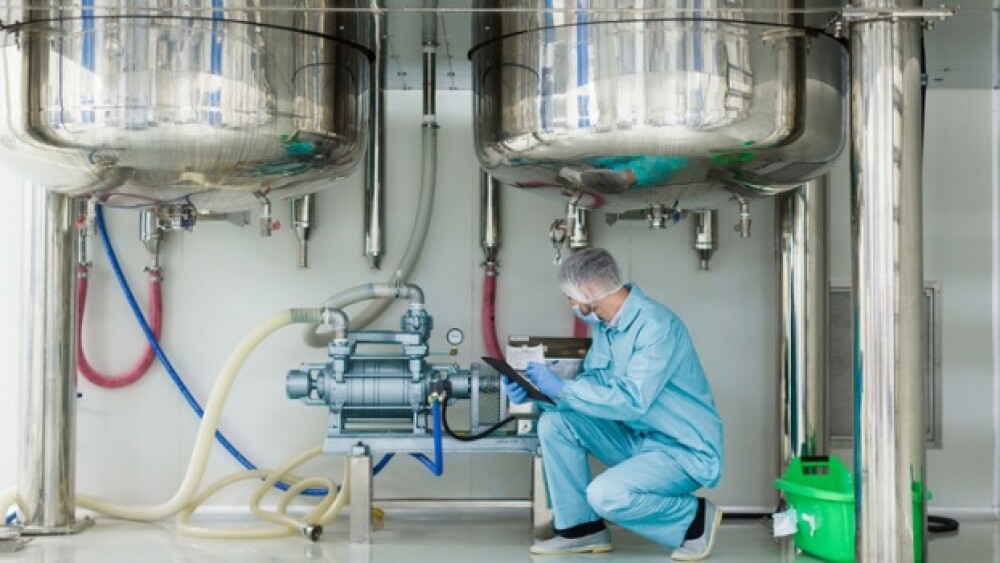The current workforce lacks the skills to move these biological treatments through the regulatory and production pipeline, a new report finds.
Pictured: Scientist in a biomanufacturing laboratory/iStock, Traimak_Ivan
Cell and gene therapies offer great promise to treat rare and debilitating diseases. Later this year, the FDA will consider Vertex and CRISPR Therapeutics’ exa-cel, a CRISPR therapy for β-thalassemia and sickle cell disease. The agency is also scheduled to review nine additional cell and gene therapies (CGT) that address type 1 diabetes, amyotrophic lateral sclerosis (ALS), metastatic melanoma and Duchenne muscular dystrophy.
Despite the positive steps forward, the Alliance for Regenerative Medicine (ARM) published a report in March that found the sector’s workforce is lacking in technical skills, such as development and manufacturing. The workforce is also deficient in key areas of production, like artificial intelligence (AI) and automation, the report stated, as well as quality control and assurance analytical development. ARM cautioned that if this trend persists, it could threaten the sector’s ability to reach its full potential.
“Cell and gene therapies, as a sector, is a relatively new field in the regenerative medicine field,” Natalie Fekete, ARM’s manager for science and industry affairs, told BioSpace. “It is growing and evolving rapidly, which means it needs more people.”
In the report, ARM identified the top skills that universities could address to elevate an education above basic science, including information technology, AI and automation, data management and analysis and programming. In addition, new certificate and training programs could strengthen the skillset of the current workforce to bolster the sector until more workers are trained and brought online, the report said.
“The gene/cell therapy industry operates in a fast-paced and dynamic environment, so the ability to work under pressure and adapt to changing priorities and timelines is highly valued,” Fabian Gerlinghaus, co-founder and CEO of cell therapy manufacturer Cellares, told BioSpace by email. “A well-rounded new employee in gene/cell therapy should be open to continuous learning and professional development to keep up with the rapidly evolving nature of the field.”
Filling this skills gap will be challenging, however, as the sector is hampered by a small talent pool, ARM found. Growing the workforce begins by engaging the public to increase awareness of this field as a career option, according to the report. In addition, Fekete said, adjacent industries, like pharmaceuticals production, could train employees to develop the skills to work with living drugs or new genetic therapeutics.
This workforce skills gap in CGT raised the attention of the White House, which in June issued an action plan to expand biotechnology and biomanufacturing education and job-training programs rapidly and equitably across the United States. According to Fekete, the action plan will develop mentorship programs, strategies to raise awareness of this sector as a career option and new paths for workers in adjacent industries to train and join the workforce.
“ARM is, in general, working to better inform the public and policymakers about the science, and the ways the healthcare system needs to adapt to provide access to these treatments,” Stephen Majors, global head of communications at ARM, told BioSpace. “All of these things together can help raise awareness about the sector that should in turn, of course, lead to more interest in the different ways people can participate and make a career out of the sector.”
Regulatory Gaps Also an Issue
The CGT skills gap isn’t just a problem in manufacturing, but at the level of regulatory agencies as well. At the FDA, for example, qualified people are needed to manage the more than 900 cell and gene therapies already in the regulatory pipeline for review and possible approval. If the agency doesn’t get more staff, it could slow the review of applications, hindering a product’s path toward commercialization, Karin Hoelzer, director of policy and regulatory affairs at the National Organization for Rare Disorders, told BioSpace.
“One of the greatest lessons learned from COVID was that the ability to interact early and often with drug sponsors was tremendously important for the speed of bringing drugs to market,” Hoelzer said. “One of the biggest challenges for the FDA has been having enough reviewers to be able to be as approachable as possible.”
To address this need, Congress included additional funds as part of the reauthorization of the Prescription Drug User Fee Act to support FDA’s workforce and to create the Office of Therapeutic Products, which is currently working to fill some 500 positions. These efforts will help regulatory agencies meet the demand from cell and gene therapy approvals, the ARM report stated, which are anticipated to increase to 10–20 new treatments annually by 2025.
“Cell [and] gene therapies are game changers for many in the disease communities,” Hoelzer told BioSpace. “We are really facing devastating and often debilitating diseases, and cell [and] gene therapies offer unique hope to change that and change the trajectory of lives.”
Stacy Kish is a freelance science writer based in Pittsburgh, PA. Reach her at earthspin.blog.
Correction (August 31): This story has been updated from its original version to remove the incorrect statement that exa-cel has been approved in Europe. BioSpace regrets the error.





